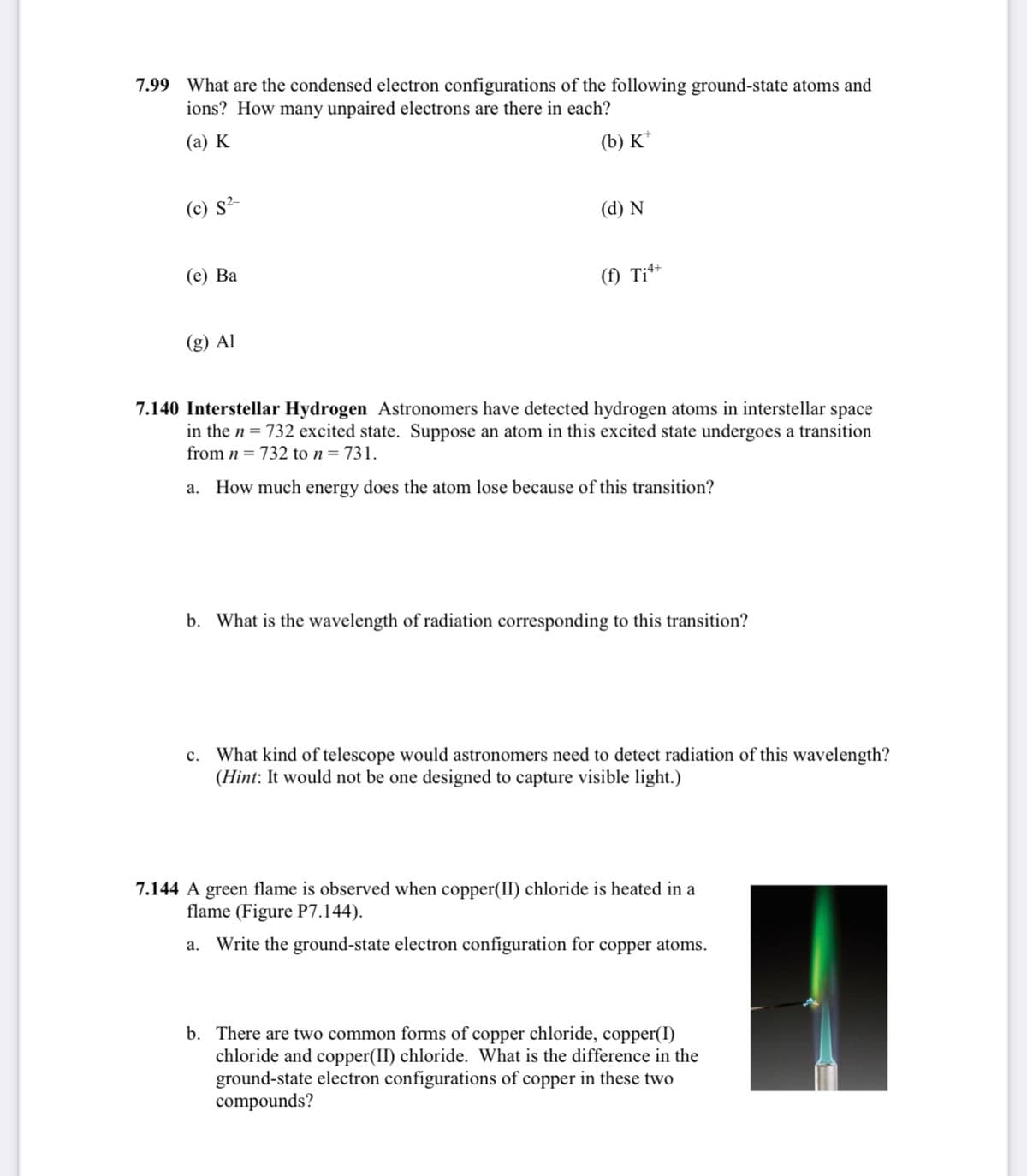7.99 What are the condensed electron configurations of the following ground-state atoms and ions? How many unpaired electrons are there in each? (а) К (b) K* (c) S- (d) N (е) Ва (f) Ti** (g) Al
7.99 What are the condensed electron configurations of the following ground-state atoms and ions? How many unpaired electrons are there in each? (а) К (b) K* (c) S- (d) N (е) Ва (f) Ti** (g) Al
Chemistry: The Molecular Science
5th Edition
ISBN:9781285199047
Author:John W. Moore, Conrad L. Stanitski
Publisher:John W. Moore, Conrad L. Stanitski
Chapter5: Electron Configurations And The Periodic Table
Section: Chapter Questions
Problem 141QRT
Related questions
Question
I need help with 7.140

Transcribed Image Text:7.99 What are the condensed electron configurations of the following ground-state atoms and
ions? How many unpaired electrons are there in each?
(а) К
(b) K*
(c) S²-
(d) N
(е) Ва
(f) Ti**
(g) Al
7.140 Interstellar Hydrogen Astronomers have detected hydrogen atoms in interstellar space
in the n = 732 excited state. Suppose an atom in this excited state undergoes a transition
from n = 732 to n= 731.
a. How much energy does the atom lose because of this transition?
b. What is the wavelength of radiation corresponding to this transition?
c. What kind of telescope would astronomers need to detect radiation of this wavelength?
(Hint: It would not be one designed to capture visible light.)
7.144 A green flame is observed when copper(II) chloride is heated in a
flame (Figure P7.144).
a. Write the ground-state electron configuration for copper atoms.
b. There are two common forms of copper chloride, copper(I)
chloride and copper(II) chloride. What is the difference in the
ground-state electron configurations of copper in these two
compounds?
Expert Solution
This question has been solved!
Explore an expertly crafted, step-by-step solution for a thorough understanding of key concepts.
This is a popular solution!
Trending now
This is a popular solution!
Step by step
Solved in 2 steps with 2 images

Knowledge Booster
Learn more about
Need a deep-dive on the concept behind this application? Look no further. Learn more about this topic, chemistry and related others by exploring similar questions and additional content below.Recommended textbooks for you

Chemistry: The Molecular Science
Chemistry
ISBN:
9781285199047
Author:
John W. Moore, Conrad L. Stanitski
Publisher:
Cengage Learning

General Chemistry - Standalone book (MindTap Cour…
Chemistry
ISBN:
9781305580343
Author:
Steven D. Gammon, Ebbing, Darrell Ebbing, Steven D., Darrell; Gammon, Darrell Ebbing; Steven D. Gammon, Darrell D.; Gammon, Ebbing; Steven D. Gammon; Darrell
Publisher:
Cengage Learning

Chemistry for Engineering Students
Chemistry
ISBN:
9781337398909
Author:
Lawrence S. Brown, Tom Holme
Publisher:
Cengage Learning

Chemistry: The Molecular Science
Chemistry
ISBN:
9781285199047
Author:
John W. Moore, Conrad L. Stanitski
Publisher:
Cengage Learning

General Chemistry - Standalone book (MindTap Cour…
Chemistry
ISBN:
9781305580343
Author:
Steven D. Gammon, Ebbing, Darrell Ebbing, Steven D., Darrell; Gammon, Darrell Ebbing; Steven D. Gammon, Darrell D.; Gammon, Ebbing; Steven D. Gammon; Darrell
Publisher:
Cengage Learning

Chemistry for Engineering Students
Chemistry
ISBN:
9781337398909
Author:
Lawrence S. Brown, Tom Holme
Publisher:
Cengage Learning

Chemistry: An Atoms First Approach
Chemistry
ISBN:
9781305079243
Author:
Steven S. Zumdahl, Susan A. Zumdahl
Publisher:
Cengage Learning

Chemistry
Chemistry
ISBN:
9781305957404
Author:
Steven S. Zumdahl, Susan A. Zumdahl, Donald J. DeCoste
Publisher:
Cengage Learning
